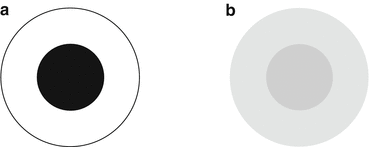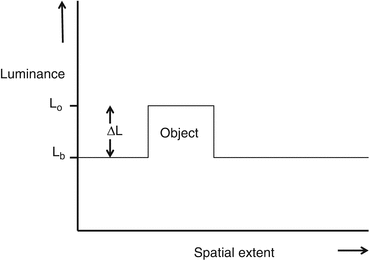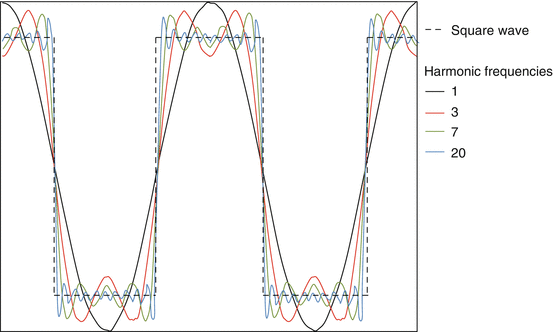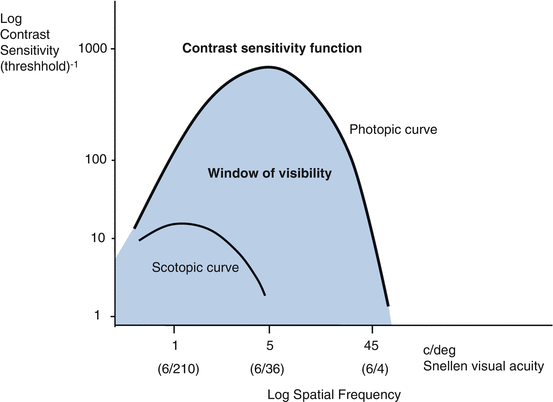(1)
University of Sydney, Sydney, Australia
Overview: Relevance of Contrast Sensitivity to Daily Function
1.
Contrast sensitivity and visual function
Contrast is a measure of the lightness or darkness of an object compared to its background.
For example, a black object on a white background has high contrast; a gray object against a slightly lighter background has low contrast (Fig. 20.1).

Fig. 20.1
(a) High contrast between object (small circle) and background (large circle). (b) Low contrast

Fig. 20.2
Contrast of an object against a uniform background

Fig. 20.3
Sinusoidal grating pattern

Fig 20.4
The optical modulation transfer function of the human visual system

Fig 20.5
A. The neural modulation transfer function. B. The combined modulation transfer function of the human visual system
Daily visual function requires an ability to distinguish contrast for a range of image sizes.
Each size is relevant for different tasks, e.g., reading small font vs seeing a step.
The object size influences how much contrast is needed to differentiate it from its background.
Contrast sensitivity (CS) is important for many aspects of visual function, including motion detection, visual field, and visual adaptation.
2.
Contrast sensitivity vs visual acuity (see Chap. 19, Visual Acuity)
Patients with normal visual acuity (VA) may complain of poor vision if CS is reduced.
VA is a measurement of spatial resolution (ability to discern minimal stimulus size) when contrast is high and constant [1, 2].
CS is a broader measurement of the visual system’s ability to discern contrast (differences in luminosity) at different spatial frequencies.
Spatial frequency is inversely proportional to spatial extent (stimulus size).
Contrast Sensitivity: The Basics
1.
Contrast for objects against a uniform background (Fig. 20.2)
Contrast (C) is measured as the luminance difference between object (Lo) and background (Lb).
If the background is constant, the Weber formula is used to measure contrast:
Weber formula:
CS is the ability to detect a change in luminance on a uniform background [4].
Contrast threshold (CT) is the smallest amount of contrast needed to detect a stimulus.
CT is the reciprocal of CS [7].
CS is determined by the:
(a)
Stimulus contrast: luminance (ΔL) of the stimulus compared with the background (Lb)

2.
Contrast for objects of varying luminance: sinusoidal gratings (Fig. 20.3)
Most real-world objects and backgrounds do not have uniform luminance and spatial extent.
Sinusoidal gratings can be used to approximate objects of varying luminance.
They can also be used to measure contrast sensitivity at different spatial frequencies.
Sinusoidal gratings are formed by a consistently repeating sinusoidal pattern of luminance characterized by spatial frequency, contrast, and phase [9]:
(i)
Spatial frequency
This is the number of adjacent dark and light lines within a spatial extent (visual angle).
It is specified in cycles per degree of visual angle (c/deg); one cycle = one dark plus one light bar.
Densely packed lines have high spatial frequency; sparsely packed have low spatial frequency.
For example, for a spatial frequency of 30 c/deg, there are 30 alternating black and white stripes per degree (60 min), and each stripe subtends 1 min of arc.
Hence, 30 c/deg is equivalent to Snellen 6/6 (see Chap. 19, Visual Acuity).
(ii)
Contrast
Contrast is measured for sinusoidal gratings (and other objects of varying luminance) using the Michaelson formula [4]:
Michaelson formula: 

(iii)
Phase
Phase is the position of the peaks relative to the start on the grating.
Measurement of Contrast Sensitivity
1.
Sinusoidal gratings are used to determine the modulation transfer function.
The modulation transfer function (MTF) can be used to evaluate the contrast sensitivity of a visual system, by assessing the integrity of light transmission through that system [9, 10].
It is determined by passing test patterns of sinusoidal gratings of known contrast and spatial frequency (the input gratings) through the system and measuring the resultant image, also a sinusoidal grating (the output grating) [11].
Sinusoidal gratings are useful because even after they are degraded by the system, they maintain their characteristic sinusoidal shape [12].
Degradation of the sinusoidal grating results in reduction in amplitude (i.e., contrast) and change in phase (altered position of the peaks).
2.
The human modulation transfer function
The human MTF function is a measure of our contrast sensitivity.
The overall human MTF is determined by the combined optical and neural MTFs:
(i)
(ii)
(iii)
The combined human modulation transfer function (Fig. 20.5)
This describes the visual system’s contrast thresholds over a range of spatial frequencies [2, 9, 10].
The combined MTF has a higher CS than the optical curve and lower CS than the neural curve.
Like the neural MTF curve, the combined MTF curve peaks for middle frequencies and tapers greatly for high and slightly for low spatial frequencies [16].
3.
The human spatial contrast sensitivity function (Fig. 20.6)
This function, similar to the human MTF, describes human light visibility based on spatial frequency and contrast [3–6, 15].
The curve describing human spatial contrast has:
(a)
y axis: log contrast sensitivity
(b)
x axis: log spatial frequency
The curve is shaped like an inverted “U.”
Photopic CS peaks in the middle at approximately 5 c/deg (6/36 Snellen).
It is degraded for high and very low frequencies.
For high frequencies, there is an abrupt cutoff at around 45 c/deg (6/4.5 Snellen), representing the human limit of visual acuity.
There is a more gradual taper for low frequencies.
4.
Non-sinusoidal stimuli
The MTF is a good measure of CS for sinusoidal gratings; however, most real-world visual stimuli do not have sinusoidal luminance patterns.
To evaluate CS for non-sinusoidal light patterns, the Fourier transformation is used.
The Fourier transformation considers any non-sinusoidal (e.g. square-age) pattern grating as the sum of multiple sinusoidal components (harmonics) of varying spatial frequencies (Fig. 20.7).

Fig. 20.7
Fourier transformation: a square grating can be considered the sum of harmonic sinusoidal components
For most non-sinusoidal gratings, the contrast threshold is determined by the fundamental Fourier sinusoidal waveform [17].
Most non-sinusoidal gratings cannot be distinguished from sinusoidal gratings unless their higher harmonic components reach independent threshold.
Factors That Influence Contrast Sensitivity
1.
Scotopic vs photopic conditions (see Chap. 21. Luminance Range for Vision)
The retina has a duplex photoreceptor system: the rod (scotopic) and cone (photopic) systems.
These systems provide complementary visual function for low and high luminance, respectively.

Stay updated, free articles. Join our Telegram channel

Full access? Get Clinical Tree



